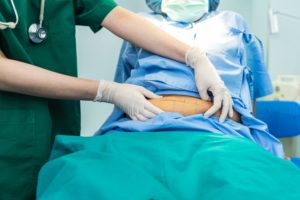 Laparotomy describes any surgery that requires an incision through the abdominal wall into the abdomen. As one of the nation’s foremost abdominal hernia specialists, Dr. Gregory Dumanian has treated many incisional hernias that have developed after patients undergo laparotomy. To learn more about why hernias are more likely after abdominal surgery, continue reading this blog.
Laparotomy describes any surgery that requires an incision through the abdominal wall into the abdomen. As one of the nation’s foremost abdominal hernia specialists, Dr. Gregory Dumanian has treated many incisional hernias that have developed after patients undergo laparotomy. To learn more about why hernias are more likely after abdominal surgery, continue reading this blog.
Why Laparotomy Is Performed
A surgeon may decide to perform laparotomy to either treat or help diagnose a health issue pertaining to the abdomen. Reasons that can warrant laparotomy include trauma, bowel obstruction, internal bleeding, diverticulitis, cholecystitis, appendicitis, aneurysm/blood vessel repair, a perforated organ, or to perform a hysterectomy.
Approaches to Laparotomy
There are several laparotomy techniques, distinct based upon where the incision is placed, including:
- Midline approach
- Flank approach
- Subcostal approach
- Chevron or Mercedes approach
- Pfannenstiel Approach
- Transverse Approach
- Minimally invasive approaches, typically near the umbilicus
The most common approach is to use the midline incision, which creates a vertical incision down the center of the abdomen.
Hernial Risk Following Laparotomy
Researchers have found that as many as one in four laparotomy patients go on to develop an abdominal hernia. This occurs because either the strength of the abdominal wall does not resist the forces applied onto the repair site due to coughing, straining, exercising, and living. The sutures tear through the muscle and fascia — a phenomenon called “suture pull-through.” When this happens, it occurs soon after surgery. Unfortunately, the abdominal wall scar of a closure with standard sutures is never as strong as the abdominal wall before surgery — at most it is 70% as strong. For some patients, especially those with high demands for lifting, or in very heavy patients, 70% is not strong enough and a hernia develops. Patients who have postoperative infections after laparotomy have a high incidence of development of a hernia. Given the elevated risk for hernia, any patient who has had a laparotomy should know the symptoms of a hernia and seek medical attention if and when concerns arise. The hallmark of an abdominal hernia is a shape change in the abdominal contour and a soft feeling when the abdominal bulge is palpated.
Laparoscopy as an Alternative
When possible, many of today’s doctors forego laparotomy in favor of laparoscopy because it facilitates an easier recovery and fewer complication risks such as incisional hernia. Instead of making a larger incision to access and see inside the abdomen, laparoscopy uses a small incision, just large enough to insert a miniature camera which can transmit the necessary information to the doctor. Laparoscopy related hernias are still incisional hernias, but they don’t get as big because the original abdominal wall cut is much smaller. Unfortunately, laparoscopy cannot replace laparotomy in all situations, particularly when the source of abdominal pain is unknown.
What You Should Do If You Do Have a Hernia
If you do develop an abdominal hernia following a laparotomy, it is important to seek prompt care from a skilled surgeon like Dr. Dumanian. He uses advanced techniques and mesh sutures in order to limit suture pull-through to achieve a successful result. To schedule a consultation, please call 312-695-6022.

